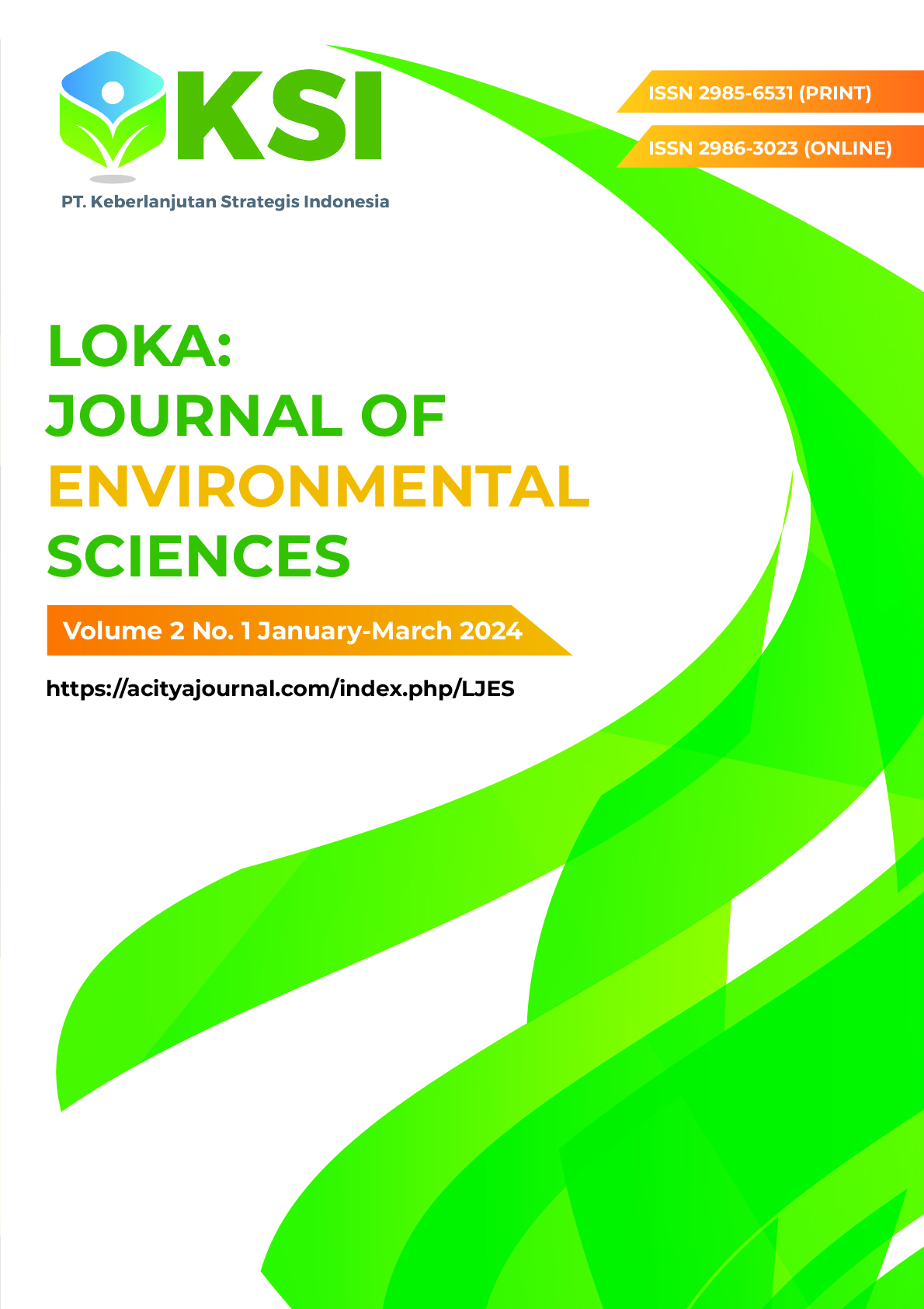A Bibliometric Analysis of Biodiversity Reporting in Accounting
DOI:
https://doi.org/10.38142/ljes.v1i3.166Keywords:
Bibliometric Analysis, Biodiversity Reporting, Biodiversity, AccountingAbstract
Purpose:
Over the years, biodiversity reporting has received increasing interest due to its importance in understanding our impact on the environment and biodiversity loss. The purpose of this study is to present a bibliometric analysis of emerging and relevant publications on biodiversity reporting in accounting.
Methodology:
This study synthesizes previous works of literature on biodiversity reporting in accounting using the bibliometric analysis approach. The data covering the period of 1996 - 2021 was collected using the Scopus database to ascertain the publications, countries, authors, keywords, and journals that have contributed to the body of knowledge. VOSviewer software was used as a visual output for the relevant data points and interpretation.
Findings:
The findings showed that biodiversity reporting in accounting is still an emerging topic, and there are continued maturing interests.
Implication:
This paper concludes by highlighting the main trends in research on biodiversity reporting and offers potential opportunities for future research in this field.
Downloads
References
Altman, D. G., Moher, D., Liberati, A., & Tetzlaff, J. (2009). Preferred Reporting Items for Systematic Reviews and Meta-Analyses: The PRISMA Statement. PLoS Medicine, 6(7), e1000097. https://doi.org/10.1371/journal.pmed.1000097
Adler, R., Mansi, M., Pandey, R., & Stringer, C. (2017). United Nations decade on biodiversity. Accounting, Auditing & Accountability Journal, 30(8), 1711–1745. https://doi.org/10.1108/AAAJ-04-2015-2028
Adler, R., Mansi, M., & Pandey, R. (2018). Biodiversity and Threatened Species Reporting by the Top Fortune Global Companies. Accounting, Auditing and Accountability Journal, 31(3), 787–825. https://doi.org/10.1108/AAAJ-03-2016-2490
Atkins, J., Gräbsch, C., & Jones, M. (2014). Biodiversity Reporting: Exploring its Anthropocentric Nature Chapter. In Jones (Ed.), Accounting for biodiversity (pp. 213–215). London and New York, NY: Routledge
Börner, K., Chen, C., & Boyack, K. W. (2003). Visualizing Knowledge Domains. Annual Review of Information Science and Technology, 37(1), 179–255. https://doi.org/10.1002/aris.1440370106
Clarivate Analytics. (2017). Web of Science Product Webpage. Retrieved from https://clarivate.com/products/web-of-science/
Culnan, M. J. (1987). Mapping the Intellectual Structure of MIS, 1980–1985: A Cocitation Analysis. Mis Quarterly, 11(3), 341–353. https://doi.org/10.2307/248680
DeLong, D. C. (1996). Defining Biodiversity. Wildl. Soc. Bull. 24, 738–749.
Deveci, İ. (2022). Review of Entrepreneurship Education Literature in Educational Contexts: Bibliometric Analysis. Participatory Educational Research, 9(1), 214–232. https://doi.org/10.17275/per.22.12.9.1
Gaia, S. & Jones, M. (2020). "Biodiversity Reporting for Governmental Organisations: Evidence from English Local Councils," Accounting, Auditing & Accountability Journal, Vol. 33 No. 1, pp. 1–31. https://doi.org/10.1108/AAAJ-05-2018-3472
Hassan, A., Elamer, A. A., Lodh, S., Roberts, L., & Nandy, M. (2021). The Future of Non-Financial Businesses Reporting: Learning from the Covid-19 Pandemic. Corporate Social Responsibility and Environmental Management, 28(4), 1231-1240.
Hassan, A. M., Roberts, L., & Atkins, J. (2020). Exploring Factors Relating to Extinction Disclosures: What Motivates Companies to Report on Biodiversity and Species Protection? Business Strategy and the Environment, 29(3), 1419–1436. https://doi.org/10.1002/csr.2145
Hirsch, J. (2005). An Index to Quantify an Individual's Scientific Research Output. Proceedings of the National Academy of Sciences of the United States of America, 102(46), https://doi.org/10.1073/pnas.0507655102
Hoppen, N. H. F., & de Souza Vanz, S. A. (2016). Neurosciences in Brazil: A Bibliometric Study of Main Characteristics, Collaboration and Citations. Scientometrics, 109(1), 121–141. https://doi.org/10.1007/s11192-016-1919-0
International Finance Corporation (IFC). (2006). The Relationship of Business to Biodiversity. Retrieved January 2, 2021 from https://www.ifc.org/wps/wcm/connect/topics_ext_content/ifc_external_corporate_site/sustainability-at-ifc/publications/biodiversityguide_understanding_business
Jones, M., & Solomon, J. (2013). Problematising Accounting for Biodiversity. Accounting, Auditing & Accountability Journal, 26(5), 668–687. https://doi.org/10.1108/AAAJ-03-2013-1255
KPMG. (2020). The Time has Come: The KPMG Survey of Sustainability Reporting 2020. Retrieved January 2, 2021 from https://assets.kpmg/content/dam/kpmg/be/pdf/2020/12/The_Time_Has_Come_KPMG_Survey_of_Sustainability_Reporting_2020.pdf
Li, K., Rollins, J. & Yan, E. (2018). Web of Science use in Published Research and Review Papers 1997–2017: A Selective, Dynamic, Cross-Domain, Content-Based Analysis. Scientometrics 115, 1–20. https://doi.org/10.1007/s11192-017-2622-5
Maharani, N. K. A. M., Jayawarsa, A. K., & Paramananda, N. (2024). The Influence of Leadership Style, Motivation, and Stress on the Performance of Denpasar Public Library Employees. Loka: Journal Of Environmental Sciences, 1(1), 36-42.
Martínez-López, F. J., Merigó, J. M., Valenzuela-Fernández, L., & Nicolás, C. (2018). Fifty years of the European Journal of Marketing: A Bibliometric Analysis. European Journal of Marketing, 52(1/2) 439-468. https://doi.org/10.1108/EJM-11-2017-0853
Merigó, J. M., & Yang, J. (2017). A Bibliometric Analysis of Operations Research and Management Science. Omega (United Kingdom), 73, 37-48. https://doi.org/10.1016/j.omega.2016.12.004
Pielou, E. C. (1977). Mathematical Ecology. John Wiley & Sons, New York.
Pranckutė, R. (2021). Web of Science (WoS) and Scopus: The Titans of Bibliographic Information in Today’s Academic World. Publications, 9(1), 12. https://doi.org/10.3390/publications9010012
OECD. (2019). Biodiversity: Finance and the Economic and Business Case for Action, Report Prepared for the G7 Environment Ministers’ Meeting, 5-6 May 2019.
Sarkar, S. (2001). Defining “Biodiversity”; Assessing Biodiversity, The Monist, Volume 85, Issue 1, 1 January 2002, Pages 131–155. https://doi.org/10.5840/monist20028515
Shareefa, M., & Moosa, V. (2020). The Most-Cited Educational Research Publications on Differentiated Instruction: A Bibliometric Analysis. European Journal of Educational Research, 9(1), 331–349. https://doi.org/10.12973/eu-jer.9.1.331
Solomon, J. F., Solomon, A., Joseph, N. L., & Norton, S. D. (2013). Impression Management, Myth Creation and Fabrication in Private Social and Environmental Reporting: Insights from Erving Goffman. Accounting, Organizations and Society, 38(3), 195–213. https://doi.org/10.1016/j.aos.2013.01.001
Talbot, D., & Boiral, O. (2018). GHG Reporting and Impression Management: An Assessment of Sustainability Reports from the Energy Sector. Journal of Business Ethics, 147(2), 367–383. https://doi.org/10.1007/s10551-015-2979-4
Talbot, D., & Boiral, O. (2021). Public Organizations and Biodiversity Disclosure: Saving Face to Meet a Legal Obligation? Business Strategy and the Environment, 30(5), 2571–2586. https://doi.org/10.1002/bse.2764
Tijjani, B., Ashiq, M., Siddique, N., Khan, M.A. and Rasul, A. (2021). "A Bibliometric Analysis of Quality Research Papers in Islamic Finance: Evidence from Web of Science," ISRA https://doi.org/10.1108/IJIF-03-2020-0056
United Nations. (2020). Retrieved January 2, 2021 from https://www.unep.org/news-and-stories/story/2020-crunch-year-biodiversity-and-climate-emergencies
Utkarsh, & Sigala, M. (2021). A Bibliometric Review of Research on COVID-19 and Tourism: Reflections for Moving Forward. Tourism Management Perspectives, 40, 100912. https://doi.org/10.1016/j.tmp.2021.100912
Van Eck, N. J., & Waltman, L. (2010). Software Survey: VOSviewer, A Computer Program for Bibliometric Mapping. Scientometrics, 84(2), 523–538. https://doi.org/10.1007/s11192-009-0146-3
Varma, A., Piedepalumbo, P., & Mancini, D. (2021). Big Data and Accounting: A Bibliometric Study. International Journal of Digital Accounting Research, 21, 203-238. https://doi.org/10.4192/1577-8517-v21_8
Verdianti, N. L. P. N., Rustini, N. M., & Dewi, A. I. K. G. (2024). The Influence of Leadership, Physical Work Environment and Discipline on Employee Performance at PT. BPR Mambal Abiansemal. Loka: Journal Of Environmental Sciences, 1(1), 24-30.
World Economic Forum. (2021). The Global Risks Report 2021. Retrieved January 2, 2021 from https://www.weforum.org/reports/the-global-risks-report-2021
World Economic Forum. (2020). Retrieved January 2, 2022, from https://www3.weforum.org/docs/WEF_New_Nature_Economy_Report_2020.pdf
World Health Organisation. (2020). Coronavirus. Retrieved January 2, 2021 from https://www.who.int/health-topics/coronavirus#tab=tab_1
Xue, X., Wang, L., Yang, R.J. (2018). Exploring the Science of Resilience: Critical Review and Bibliometric Analysis. Nat. Hazards 90(1), 477–510. https://doi.org/10.1007/s11069-017-3040-y
Zhu, J.; Liu, W. A Tale of Two Databases: The Use of Web of Science and Scopus in Academic Papers. Scientometrics 2020, 123, 321–335. https://doi.org/10.1007/s11192-020-03387-8
Zhao, D., & Strotmann, A. (2008). Comparing All-Author and First-Author Cocitation Analyses of Information Science. Journal of Informetrics, 2(3), 229–239. https://doi.org/10.1016/j.joi.2008.05.004
Downloads
Published
Issue
Section
License
Copyright (c) 2024 Drae BENT, Elisabete VIEIRA, Mara MADALENO

This work is licensed under a Creative Commons Attribution-NonCommercial 4.0 International License.
Creative Commons Attribution-NonCommercial 4.0 International License.

















